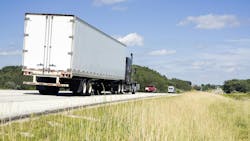Clark: Five ways fleets can minimize the cost of congestion
Key takeaways:
- Use advanced technology for AI route optimization and telematics to enhance efficiency and avoid traffic.
- Optimize delivery scheduling by adjusting to off-peak hours and offering flexible windows to reduce congestion impact and costs.
- Focus on driver training and preventive maintenance to reduce breakdowns and improve vehicle longevity.
Construction zones. Emergency roadwork. Multi-mile backups caused by everything from minor fender benders to massive infrastructure projects. If you’re managing a fleet, chances are you’re feeling the pressure of increased congestion—and so are your margins.
You’re not imagining things: Congestion is getting worse. The 2024 TomTom Traffic Index showed a 9% jump in U.S. traffic congestion compared to 2023. And the financial toll? According to the American Transportation Research Institute Cost of Congestion study, published in December of last year, congestion cost the trucking industry $108 billion in 2022 (the latest year stats are available), up $14 billion from the year prior. That’s the equivalent of 430,000 commercial truck drivers sitting idle for an entire work year. The per-truck cost? A staggering $7,588—just for sitting in traffic.
Fleet owners and operators know that time is money; in this case, wasted time is a direct hit to profits. From missed delivery windows and unhappy customers to higher fuel and labor costs, the ripple effects of congestion are far-reaching.
Fortunately, fleet managers aren’t powerless. These five strategies represent high-impact opportunities to lessen the burden of congestion and increase fleet efficiency.
1. Advanced route optimization
Modern route planning systems offer more than just a roadmap. They make real-time decisions based on current traffic, weather conditions, and historical data to find the fastest, most fuel-efficient path. Using AI-powered tools, fleets can:
- Avoid known bottlenecks and construction zones
- Recalculate routes in real time based on traffic incidents
- Reduce drive time, idling, and fuel waste
Some platforms even account for delivery windows, vehicle load, and regulatory compliance (like HOS limits) to ensure optimal performance.
2. Telematics and GPS
Telematics provides a window into every truck’s location, condition, and performance. Combined with GPS, it allows fleet managers and dispatchers to:
- Monitor vehicles in real time
- Spot upcoming delays and deploy reroutes
- Communicate instantly with drivers
This kind of visibility can enable a dispatcher to redirect a truck around a significant backup well before it’s even in sight. Telematics can also help reduce costs by reducing the risk of accidents by flagging hard braking, speeding, or erratic driving.
3. Alternative delivery times
Rush hour traffic is predictable—and avoidable. While not all deliveries can happen at midnight, many companies can dramatically reduce congestion exposure by:
- Scheduling deliveries during off-peak hours (midday, overnight, weekends)
- Working with customers and warehouse partners to offer flexible delivery windows
- Adjusting driver shifts to match optimal traffic patterns
Although this change requires some logistical coordination, it can result in substantial savings in fuel and time for routes that pass through highly congested metro areas.
See also: Indiana authorizes interstate highway tolling
4. Ongoing maintenance
Traffic isn’t just hard on drivers—it’s brutal on trucks. Constant stop-and-go traffic and excessive idling can wear down brakes, engines, and transmissions. That’s why preventive maintenance is more critical than ever. Fleets that prioritize scheduled maintenance and predictive diagnostics will:
- Reduce unplanned breakdowns in the middle of traffic (and the costly tows that follow)
- Keep engines running at optimal efficiency during stop-and-go conditions
- Extend vehicle lifespan
In addition, investing in trucks with updated fuel-efficient engines, aerodynamic features, or idle-reduction technologies can improve mpg even in the worst traffic conditions.
5. Driver training
Drivers are the front line in the battle against congestion. And while technology is a powerful ally, it’s even more effective in the hands of well-trained professionals. Fleet managers should ensure that drivers are:
- Familiar with the navigation tools in their cabs
- Trained in defensive driving techniques for congested conditions
- Kept informed about common traffic trouble spots in their delivery zones
- Empowered to make decisions in the field when rerouting is necessary
A knowledgeable, tech-savvy driver is not only safer but also better equipped to save time and reduce unnecessary miles.
Maneuvering through gridlock
Let’s be clear: Traffic congestion isn’t going away anytime soon. In fact, with rising population density, aging infrastructure, and growing e-commerce demands, it’s likely to get worse before it gets better. But that doesn’t mean fleets are powerless. By leaning into data, technology, and smart planning, fleet operators can take control of the bottom line ... and the road ahead.
About the Author
Jane Clark
Senior VP of Operations
Jane Clark is the senior vice president of operations for NationaLease. Prior to joining NationaLease, Jane served as the area vice president for Randstad, one of the nation’s largest recruitment agencies, and before that, she served in management posts with QPS Companies, Pro Staff, and Manpower, Inc.
